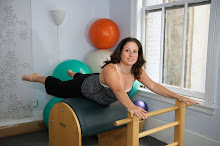

When teaching at JCHS from 2003-2009 it was really important to me for my high school students to gain a vocabulary when talking about their bodies. This wasn't only true of the health/sex ed class, but also of the Pilates, yoga and dance classes.


For me yoga is a great place to start thinking about mindful movement. Yoga means union. The definition of that union has different interpretations. I think it is the union of the divine spirit inside us and the physical world. It is a time to reflect about how you stand, how you sit, how you breathe. When brought into a Jewish context, one can start asking questions like: where did that first breath come from? We can acknowledge that our bodies are absolutely incredible creations. We can start to appreciate the Divine context in which we live life.
This past summer I visited Sri Aurobindo’s Ashram as well as Auroville, a community that is dedicated to living out Auribindo’s teachings, creating an ethical community that is mindful, environmentally conscious and diverse. I was expecting to find a community that practiced yoga in the way that I knew it – on a mat. However, Sri Auribindo called mindful living Yoga. When one was doing organic farming, that was Yoga. When one was preparing food for others in the community, that was Yoga. When one was contributing to the community by being a security guard or artist, that was Yoga.
Yoga was not something that was done on the mat. In some ways, that community had a different challenge: getting on the mat.
So many of us practice yoga on the mat. So many of us practice mindful movement in Pilates or dance or maybe even on the treadmill. The challenge for us is to take the yoga off the mat. I’m not saying that these followers of Auribindo were perfect – far from it. But they got the idea right. Wouldn’t it be great if everyone who did yoga on the mat spent equal amount of time contributing to the community? One could argue that meditating, praying and mindful movement IS giving to the community. But I would argue that your personal experience is only one part of the puzzle. (I am married to King of Giving and Community Outreach, Rabbi Mark Asher Goodman.) In modern Judaism, you can't get away from Tikun Olam (Fixing/Healing the World) as a core principle.
This experience in Auroville made me feel more confident to take some of the Hindu out my yoga teaching. It is not the core of Yoga. With Judaism as a viable option, we don’t need to use Hindu god stories to explain our purpose in life. We have hundreds of our own stories that are rich and confusing.
We can breathe and think about our ribs expanding, what it means to give a rib to create another being (story of Adam and Eve). We can reach our heels back into the ground and imagine Jacob tugging at our heels (story of Esau and Jacob’s birth). Jewish folktales share the wisdom we have gained through the ages, often with humor. Sometimes we take it all way too seriously.
I often need to remind my clients that there is not pot of gold on the other side of that stretch. Judaism is all about the journey, not the destination. So much of the Torah focuses on wandering, not on living in a homeland. This is something to which so many of us can relate.
So now I need to write a description of a Jewish yoga class. I think I needed to get all that out before I market myself to the JCC’s of the South Bay and North Bay Jewish community. I am putting it out there that I would like to have some offer from SF. So much more convenient.
 So we are finally on the most famous of the three glut (pron. gloot) muscles, the Gluteus Maximus. In Pilates, we call the Gluteus Maximus an "on-off"muscle because it doesn't need to be used all the time. Meaning, the GM is not essential for stabilization like the psoas muscle or even the Gluteus Medius. We can stabilize our spine and pelvis without squeezing our butts. Butt squeezing might be a way of toning the muscle but it is not the way one should live life.
So we are finally on the most famous of the three glut (pron. gloot) muscles, the Gluteus Maximus. In Pilates, we call the Gluteus Maximus an "on-off"muscle because it doesn't need to be used all the time. Meaning, the GM is not essential for stabilization like the psoas muscle or even the Gluteus Medius. We can stabilize our spine and pelvis without squeezing our butts. Butt squeezing might be a way of toning the muscle but it is not the way one should live life.  The gluteus minimus is another overlooked butt muscle. It is the smallest of the three gluteal muscles. It often works together with the tensor fasciae latae (TFL). My high school students used to comment "There's a latte in your leg?". I will get to the TFL another day.
The gluteus minimus is another overlooked butt muscle. It is the smallest of the three gluteal muscles. It often works together with the tensor fasciae latae (TFL). My high school students used to comment "There's a latte in your leg?". I will get to the TFL another day. 


 I just updated my facebook fan page with my thought of the day.
I just updated my facebook fan page with my thought of the day. 